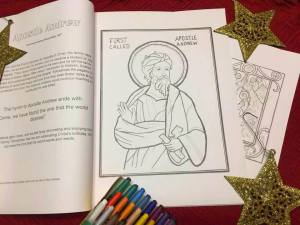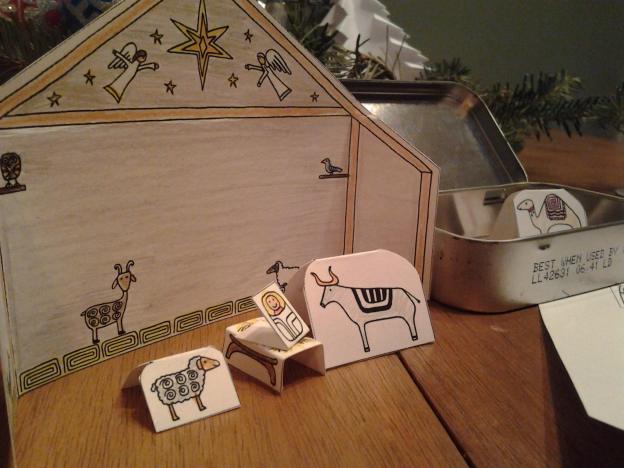We have recently come across a variety of wonderful Orthodox books and resources (mostly for children) that would be lovely Christmas gifts. We found them noteworthy enough to gather them into a little collection, so that we could share them with you, in the event that you were not aware of them.
Some of these we have shared before, but are sharing again, in case you missed them the first time. Others are brand new (or new to us, or newly re-published). Our intent is to offer gift suggestions that could double as useful tools in the growth of a young Orthodox Christian’s life. Perhaps you will find one or more of these suggestions helpful as you select gifts for your loved ones.
We know that there are many more ideas than we are able to share here, so we have missed quite a few. What child-friendly, Orthodox-faith related gift ideas do you recommend? If you are (or know!) an artisan who crafts (and sells) beautiful gifts for Orthodox Christian children, please share them below!
Here are a few Orthodox Christmas gift ideas that we encountered:
***
Ancient Faith Publishing’s brand new Nativity coloring book, “Beautiful Christmas: an Orthodox Coloring Book for Children” was created with children ages 5-12 in mind. Meagan Elizabeth Gilbert’s 59 lovely illustrations include a mix of both coloring and activity pages. Check it out, and purchase your gift copy(s) here: https://store.ancientfaith.com/beautiful-christmas-an-orthodox-coloring-book-for-children/
***
Families with very small children may be interested in this set of Nativity blocks, safe for children to hold and play with. The back of each block contains a verse of a song or prayer from the traditions of the Church, written in language that is young-child friendly. https://store.ancientfaith.com/little-saints-nativity-playset-a/
***
This learning cube transforms from one icon-style image to another, and each image includes a shortened version of the Nativity story. https://store.ancientfaith.com/orthodox-learning-cube-the-nativity/
***
Four-year-old Anthony will teach anyone who reads this book how to handle the challenges that come their way, with grace, and with God’s help. https://orthodoxchristianparenting.wordpress.com/2019/06/12/gleanings-from-a-book-anthony-the-great-by-john-sarantakis-illustrated-by-misha-pjawka/
***
Young children will resonate with Philo in this book, or any of the other books featuring his adventures with the SuperHolies! https://orthodoxchristianparenting.wordpress.com/2019/07/10/gleanings-from-a-book-philo-and-the-faithfulness-superholy-by-mireille-mishriky-illustrated-by-s-violette-palumbo/
***
As they read this book, elementary-aged children will be drawn right into young Spyros’ life as he learns from St. Spyridon – without even knowing he’s interacting with a saint! https://orthodoxchristianparenting.wordpress.com/2019/05/08/gleanings-from-a-book-spyridons-shoes-by-christine-rogers/
***
Teens and adults will benefit from the wisdom and example of St. Anthony, as shared in this graphic novel: https://orthodoxchristianparenting.wordpress.com/2019/05/29/gleanings-from-a-book-a-forest-in-the-desert-the-life-of-st-john-the-short-by-creative-orthodox/
***
Late elementary-aged children and adults alike will learn from the life of St. Eustathios in the engagingly-written and beautifully illustrated graphic novel, “The Cross and the Stag,” which we wrote about here: https://orthodoxchristianparenting.wordpress.com/2019/08/28/gleanings-from-a-book-the-cross-and-the-stag-by-gabriel-wilson/
***
Author and illustrator Grace Brooks has done it again! She has written yet another mesmerizing book about an Orthodox girl facing real-life problems and choosing to solve them with the help of her priest and the friends from her parish who are part of the “Every Tuesday Club”. The girls in this club are aging as time goes by between the publishing dates of Ms. Brooks’ books, which is a beautiful way for the series’ fans to have age-appropriate books along the way. “Xenia the Warm-Hearted” follows 14-year-old Xenia as she tries to improve the way that she interacts with others, even without the use of internet on her phone (a privilege she lost when she was online, gaming outside of her family’s rules). This book is appropriate for early teens (or older), and contains its fair share of age-appropriate struggles in the context of some mystery and suspense. Purchase your copy here: https://www.amazon.com/Xenia-Warm-hearted-Every-Tuesday-Club/dp/1698351038
Here are a few quotes (and a teaser!) from the book, to give you a taste:
“Xenia regarded him woefully. ‘I wanted to make such a change, but I’m having trouble figuring this out. I mean, it’s good to want to be a better person. But I still don’t understand people very much and… I don’t always seem to like them. I did all this research, but I don’t know what I’m supposed to do.’ …[Father Andrew answered,] ‘I think that this isn’t something that you can research by just reading about it — not even by reading the lives of the saints, though that’s an excellent place to start. You’re not going to get anywhere with a list or a guide that tells you what to do and what not to do. I can’t say enough good things about prayer, but even that is just a start.’ Father smiled at her kindly. ‘You may have to find out by doing.’” (p. 117)
“Her eyes had drifted out the window as she spoke, where the gusting wind was blowing a pillowcase on the clothesline. Energy encounters matter. Mobility and immobility. Wind resistance, oscillation, flexibility. ‘It’s very beautiful,’ she finished dreamily. ‘Not to me,’ he [Charlie] sniped, bringing her back to reality. ‘If there is a God, then why is the world such a mess?’ Xenia was used to this question as well. ‘Because there’s evil in it, too. And sometimes we are — all of us are — carriers of that, like a mosquito carries a disease. But that’s not how it was supposed to be…’” (p. 293)
“…and that’s how they found them: two frightened young people huddled together in a ruined living room with broken glass and squirting pipes. That was the sight that greeted Mr. Murphy and Jake when they pulled up a minute later, in the mistaken belief that they were coming to the rescue…” (p. 415)
***
Readers who are fans of fantasy and/or symbolism will thoroughly enjoy “The Dome Singer of Falenda” by Katherine Hyde. It has been a really long time since we read such a delightful fantasy. Originally published in 2016, and just re-published, this book filled with music and beauty, fraught with gripping adventure, and causes the reader to re-think the power of their thoughts. Themes include the power of familial love, the importance of discerning (and valuing) good over evil, and the importance of focus. The protagonist is a boy of 13, and his Falendian sidekick is a girl of 14. People of a variety of ages and genders will be entranced by their journey and uplifted by this beautiful read. Find your copy here:
https://www.amazon.com/Dome-Singer-Falenda-Katherine-Bolger-Hyde/dp/1732087326/
Here are a few quotes from the book, to give you a taste of it:
“Anyway, I’d read enough books to know that when it comes to adventures, the only way out is through.” (p. 23)
“I gasped for air. ‘What—me? You’re having me on. I’m no deliverer. I’m not brave, or strong, or clever. All I know how to do is sing.’ ‘But singing is precisely what is required. That is how we will break the Dome—by singing. The elúndina chose you for your gifts of singing and thought-speech. And also, of course, because you are your mother’s son.’” (p. 36)
“I’d been thinking of nothing in particular, but as soon as I tried to wipe my mind clear of thoughts, it filled with a whole crowd of questions…This wouldn’t do. I shook my head and tried to focus on my surroundings. I peered at the rough, ridged texture of the malacána bark, listened to the clear, musical cry of a bird, inhaled the sharp, fresh smell of the trees, like cedar mixed with peppermint and cinnamon. I felt the chafing of Vali’s thick, soft coat beneath my legs, the still, cooling air against my cheeks. When was the last time I’d stopped to pay attention to things like that? At home I was either buried in memories or planning how to cope with the next calamity. I’d forgotten how to just be.” (pp. 57-58)
“The Tower had no windows or doors that I could see, but at the center of the side facing us the ranks of guards angled outward. The door must be hidden there. It looked like my mother was right: it was impossible. The din in my head took on a new undertone: ‘You have failed, you must fly. You have failed, you must fly.’ Maybe the bad guys really were going to win. Meli’s thought-voice broke through. ‘I hear it too, Danny. But you must resist these thoughts. You must shout them down with truth. Everything that babble says is a lie, for lies are all the Enemy knows. We have not failed until we give up, and we must not give up.’ ‘I don’t want to give up. But how can we succeed? How could we ever get in there to rescue your parents, or get to the top from outside? I’m afraid I left my Spiderman gear at home.’ Meli ignored that. ‘Our parents did it seven years ago. Somehow they reached the top.’ And now they were inside.” (p. 149)
***
Homemakers in your family may enjoy this read! “Searching for the Sacred” by Lois Clymer is a book filled with the memories and musings of an Orthodox Christian wife and mother. It tells the story of her (and her husband‘s) dream for a little homestead, and how they have realized that dream in a variety of locations, over the years. Anecdotes include adventures that they’ve had with their family, and a variety of things that she has learned along the way. In addition to living on a homestead and growing much of their own food, Mrs. Clymer addresses other experiences they’ve had, including some experiences in the world of politics; finding ways to enjoy small homesteads away from home; her foray into owning and operating a CSA; and adventures and lessons learned while building two tiny houses. Throughout the book, readers will find encouragement to search for God in the world that He has created. Pick up a copy here: https://www.westbowpress.com/en/bookstore/bookdetails/778125-searching-for-the-sacred
Here are a few of our favorite quotes, a handful of Lois’ learnings, that she shares in the book, scattered amidst the stories from her life:
“Hard work is the secret to success. I soon found that it helped to be organized and to prioritize. When I did the most important thing first in the day, the rest of the day flowed more smoothly…” (p. 4)
“Most of us find that life doesn’t always go the way we wanted it to. What do we do when pain and disappointments and grief enter our lives? As a young person, I struggled with how to be happy… I came across some wise counsel regarding happiness. If I am unhappy… it is not because of my environment, but because of the way I am evaluating my environment.” (p. 14)
“I have certainly not always been perfect, and I have held on to bitterness from time to time. But I have noticed that when I can release that bitterness and let it go completely, something good happens in my body. My creativity and my joy returns. The antidote to the poison of bitterness is forgiveness and gratefulness.” (p. 23)
“Most of us don’t know much about simplicity. We have more possessions than we know what to do with. One time I heard a motivational speaker say that every possession you have uses up valuable brain space. You think about it, you catalog it, you think about cleaning and repairing it, you organize it. To lighten your brain load, think about how to live with only half of the possessions you have and then DO IT.” (p. 81)
“Wherever you live, maybe this book will motivate you to enjoy some of the simple pleasures in life: grow a plant or vegetable, take a walk through a woods, or enjoy the antics of a chicken or a goat.” (p. 86)













